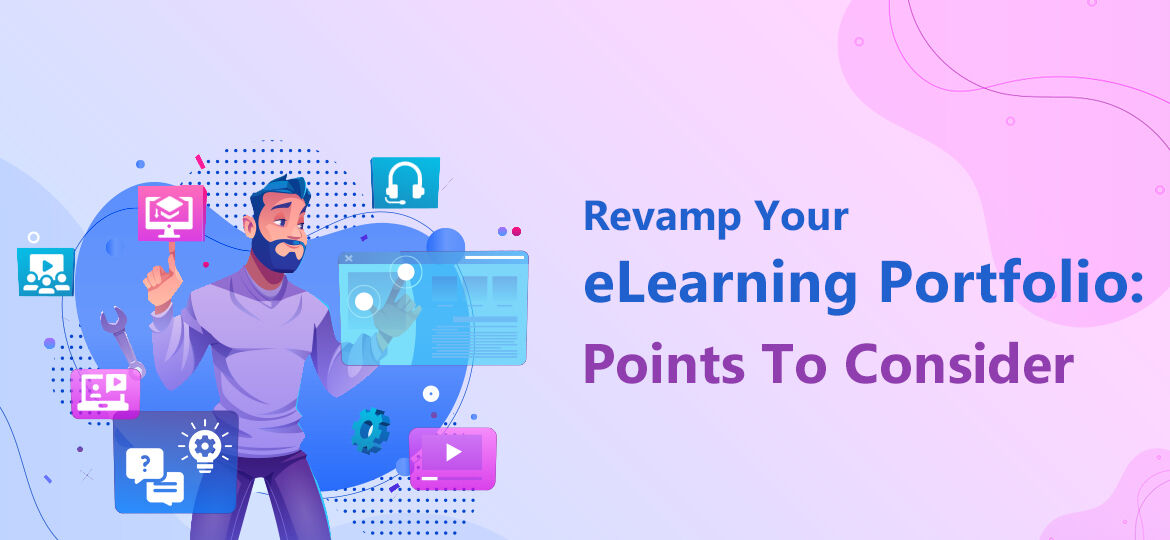
Learning is a continuous activity. Every organization needs its employees to constantly keep themselves updated with the latest knowledge so that they can execute their tasks efficiently and effectively.
eLearning Technology
With the advent of technology, organizations shifted toward an eLearning mode of content delivery. While eLearning has so many advantages, it suffers stagnancy. The content, the media, and the design all get stagnant. The only way out is to revamp the old repository of eLearning modules with the latest technology, content, and design. Let’s discuss a few points to consider for revamping your eLearning portfolio.
The very first point you should consider is whether or when you need to revamp your eLearning portfolio. Just because a module has been developed in the past does not mean you should revamp it. Evaluate the following:
- Does the content of the module need to change?
- Does the design of the module need to change?
- Does the technology of the module need to change?
If any of the answers are “yes”, then you should plan to revamp your eLearning modules. Let’s discuss how you find out the answers to the questions above.
Revamping Your eLearning Portfolio
1. Does The Content Of The Module Need To Change?
This is perhaps the most critical trigger to consider when revamping eLearning modules. Content is king. If the content of the module is not catering to the learning needs, there is no point in retaining it. Content revamp may be required in two scenarios.
First, if there is a change in technical details, for example, if there is a process change in an organization, then the training module related to the process needs to be revamped. Second, if there are demographic changes, then also the content of a module needs to be changed. For example, suppose an organization sells its products in a particular region and wants to expand its business to another region.
The sales training modules for the first region may not be suitable for the second region although the technical content may remain the same. Thus, there are two considerations to revamping the content: subject matter consideration and Instructional Design consideration, depending on the type of changes needed.
2. Does The Design Of The Module Need To Change?
Learning design plays a critical part in the effectiveness of the learning module. A scenario-based module is much more effective than a simple page-turner. The learner mindset is evolving, and the learning modules must cope with that. Gone are the days of long web-based training modules. Today’s generation is much more agile and wants their learning to be agile too. Here are a few design elements that the modern learning path must have:
- Small, frequent learning modules
Learners respond better to small modules at regular intervals, rather than one big module. - Videos
Videos are one of the best ways to enhance learner engagement. Videos are micro-sized, gain attention, and are easier to revise for the learners. Videos enable on-the-go and just-in-time learning. - Updating visual design
Visual design plays a significant role in learner engagement. The design elements need to be contemporary, keeping in mind the learners’ demographics. - Use of interactivities
Learners engage more with a module when they can interact with it, rather than just watch. Design your module with more interactivities to complement its visual design. - Gamification
Gamification is one of the best ways to ensure learner engagement. A gamified curriculum is fun and gives more insight into learner behavior.
3. Does The Technology Of The Module Need To Change?
Learning technology is evolving very rapidly. While we welcome new technology, these developments also demand that you keep up with the advancement. Advancement in technology has affected both the module creation and the module delivery mechanisms. Here are a few considerations:
- LMS
Evaluate if your Learning Management System (LMS) is offering you the latest features. The LMS is usually the most forgotten element in the learning ecosystem and tends to be ignored after installation. Modern LMSs come with a lot of features that enable learning managers to plan, track, and evaluate the learning in a better way. - Social learning
Evaluate if your eLearning systems are capable of handling modern trends in social learning which ensures maximum learner engagement. - The learning experience and analytics
Learning experience and analytics are major drivers of modern-day learning design. Consider integrating systems that enable you to utilize these modern technologies.
Learning is the process of continuous improvement. So, the learning modules should also be continuously improved, to maximize the learning outcomes.
